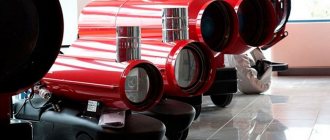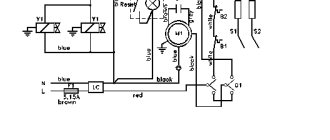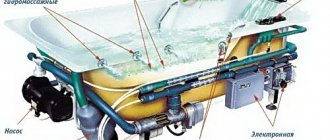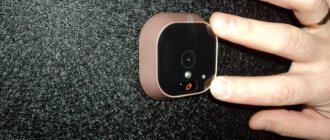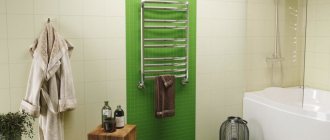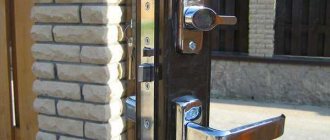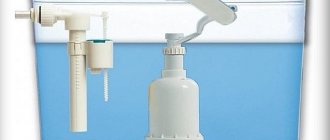What a standard dry heating element is is known not only to those who work with heating on an industrial scale, but also to everyone who has even the slightest idea about the operation of a household boiler or washing machine. The development of technological equipment also requires new approaches in the field of heating. On this basis, new heating elements were developed that have increased durability and improved protection. These devices include dry ceramic heating elements consisting of steatite modules. To have an idea of what we are talking about, we suggest considering this topic in more detail.
Dry heating elements: ceramic or tubular? Differences
What a standard dry heating element is is known not only to those who work with heating on an industrial scale, but also to everyone who has even the slightest idea about the operation of a household boiler or washing machine. The development of technological equipment also requires new approaches in the field of heating. On this basis, new heating elements were developed that have increased durability and improved protection. These devices include dry ceramic heating elements consisting of steatite modules. To have an idea of what we are talking about, we suggest considering this topic in more detail.
What is the difference between a standard metal dry heating element and a ceramic heater?
The operating principle of both heaters is not particularly different, but the performance, design and installation method are different.
- Mobility of the heating element. In dry standard electric heating elements, the heating element consists of a copper alloy or corrosion-resistant steel. When vibration occurs during equipment operation, this element can move inside the flask. In a ceramic heater, the heating element is seated tightly and is not affected by vibration during operation. Heat exchange in this case will be carried out at high quality.
- Combined heating device. In a ceramic heating element, the heating element is placed in a ceramic base, which has the property of maintaining temperature for a long time. For this reason, even after disconnecting the heating element from the network, the heater retains the accumulated heat for a long period of time. Thus, energy consumption is saved and thermal energy is retained for a long time.
Features of soapstone
Soapstone is a mineral material of natural origin. It is mined from unprocessed talc ore. In the process of studying steatite, its healing properties were revealed, but scientific researchers were more interested in its heat-storing properties. The heat-preserving properties were originally discovered after the mineral was heated and then placed in cold water, where it remained at its temperature for an hour.
Initially, people used soapstone (ceramics) to create stoves and thermal insulation coatings, using it both in pure form and in mixtures with other elements. Over time, this mineral became widely used in the manufacture of electric heaters.
Heating devices based on soapstone or ceramics are currently used to heat oil, water, plating solutions and are even installed in breweries.
Additional benefits
Ceramic can absorb excess heat while protecting the metal heating element and other metal parts that make up the heater. The corrosion processes of metal components in such a heater are much slower compared to standard devices, and the service life is increased.
Thanks to the special shape of the ceramic component of the dry heating element, its beneficial qualities can be used to the maximum, which increases its service life.
To replace a ceramic dry heater, as with a standard one, there is no need to drain the liquid from the container.
Ceramic / soapstone dry electric heaters have proven their practicality only on the positive side. They are able to operate for a long period and, with proper maintenance, provide a uniform supply of heat throughout the heated area. The safety of the generated energy saves already expensive electricity.
order a dry ceramic heating element from “Polymernagrev” by filling out an application on the website or by telephone. All contact information is listed on the website. Delivery is carried out throughout all regions of Russia.
Which air heater is better: heating element or ceramic?
When choosing an air heater, or just a heater, the first question that arises is what type of heating device to choose. After answering the first question, the required power of the selected type of device is approximately calculated so that it can heat a room of the corresponding area. Approximately 1 kW per 10 square meters. And finally they make the long-awaited purchase.
But if at first glance all these steps seem unpretentious and simple, then as soon as it comes down to it, many nuances immediately float to the surface. How to choose a device? What are the pros and cons of devices of one type or another? Which one will ultimately be better suited to the current conditions? We will try to answer these questions honestly in this article. Namely, let’s compare the two most popular today, and at the same time completely different, types of air heaters - heating element and ceramic.
Heating elements new air heaters
Heating elements are sealed tubes made of heat-resistant material, inside of which there is a spiral powered by electricity.
What is the tube for? So that the open spiral does not cause harm to surrounding objects, so that the dust in the air does not burn too much, and finally, so that the spiral does not burn out so quickly, because oxygen in the air greatly contributes to this.
Heating elements in heaters have a wavy or flat spiral shape, sometimes with fins. But the principle is always the same: the spiral inside the heating element transfers heat to the surface of the heating element, and the surface of the heating element heats the air in the room by convection, or the heat is blown off by a fan, which again helps to warm up the air.
Everything is obvious, it would seem - choose a heater with a heating element of suitable power, place it in the room and enjoy the warmth. You can choose a fan heater with a heating element, then the warm air, heated by the heating element, will blow where needed, and the goal will be achieved - the room will again be filled with warmth. However, not all so simple. The surface area of the heating element is small, and this is where the main pitfall lies.
Although heaters with open heating elements warm up quickly, they do not distribute heat evenly throughout the room. If there is no fan, then the heat will rush vertically upward, and after a few minutes a burning smell will still appear, since dust will still fall on the heating element. In addition, oxygen will be burned out, and eventually the room (or office) will become stuffy.
Thus, the small surface area of the heating element negatively affects the heating process. The air is heated up very locally by volume (only near the surface of the heating element), and, of course, it overheats, which means oxygen is burned out, it becomes stuffy, and the heat does not bring the expected comfort.
Obviously, a heating element is ideal for heating water in a tank, but it is poorly suited for heating air. Liquids inside a volume transfer heat better, while gases (air in particular) transfer heat much worse.
If we are talking about a garage, a small hangar or a warehouse of fireproof materials, where people are not present all the time, then a heating element air heater is suitable. It’s good if the room is equipped with a thermostat, then it will be possible to maintain the air temperature at the required level.
But if we are talking about a room in which people work all the time, if there are fire hazardous materials, or the air humidity is higher than usual, then a heating element heater will not work. We need another solution. Fortunately, these days there are more suitable alternatives.
Fan noise is another disadvantage of the heating element heater. The fan there is always powerful, because it is necessary to blow off the heat from the surface of the heating element of a small area, and this requires significant air pressure. Another thing is if the heating element has fins or a ventilated radiator of good area, then the fan will be quieter. One way or another, due to the presence of noise, such a heater is suitable for noisy rooms, when one of the goals is to save money when purchasing a heating device. The low cost of a heating element air heater is the main advantage of devices of this type.
Metal or ceramic heating element. What's better?
Summer greetings to everyone from Uncle Gena. Today we will try to understand the question - what is better: a ceramic “dry” heating element or a metal “wet” heating element?
Today in our everyday life you can often find a household appliance - a water heater (boiler), which is designed to serve for a long time. But hard and not very clean water can lead to premature failure of the water heater. If this trouble happens, do not despair. After all, most often, to repair it, it is enough to buy a heating element for the boiler and replace it. When buying a water heater, and in the summer, buying a boiler becomes much more relevant, since in our country it is customary to turn off hot water in the summer for maintenance work, you should pay attention to which heating element (heating element) to purchase it with. So, which heating element to choose - dry or wet?
Water heaters for apartments and private houses
What is the difference between a “wet” heating element and a “dry” one - comparative characteristics:
First, let's understand the definitions of these heating elements.
- The principle of operation of a “wet” heating element is easy to explain by comparing it with a large and powerful boiler placed inside a water heater. This type of heating element is also called “open”, “metal” or “copper”. It looks like a copper or stainless steel tube.
- The essence of a “dry” heating element is contained in its name. The stainless steel heating element does not have direct contact with water and is placed in a special durable ceramic flask.
What is a “wet” heating element?
An ordinary metal (“wet”) heating element is a kind of copper or stainless steel tube of a straight or curved shape. The heating element has direct contact with water and its temperature is close to the temperature of the water in the tank. The main advantage of such an element is its low cost, since tanks with a “wet” heating element are much cheaper.
A type of “wet” heating element
The disadvantages include several factors, but their influence is, to put it mildly, controversial. One of them is the need to completely drain the water from the tank if the heating element needs to be replaced. Another disadvantage is the risk of breakdown and, accordingly, electric shock. Well, the third factor is the formation of scale on the walls of the heating element. Regarding scale, we can say the following - its amount does not depend on what heating element is used in the tank. The water heater needs to be cleaned every year, and for this it is necessary to completely drain the water and wash both the tank and the heating element. As for breakdown and electric shock, we conducted a survey with our clients and it turned out that no one had ever dealt with such a case. In fact, if you imagine such a situation, then electric shock will look like an unpleasant pinching sensation.
What is a “dry” heating element?
The term “dry” heating element refers to the technology of heating water in water heaters and other water heating devices, where the heating element itself (TEN) is not in direct contact with water, but is located in a sealed casing. It could be a ceramic flask, or metal air-filled tubes, but the essence is the same - heat is transferred to the water through an intermediary (casing). This leads to the fact that the temperature of the water near the heating casing is much lower than the temperature of the heating element, as a result of which scale is formed in much smaller quantities.
A type of “dry” heating element
It is for this reason that the service life of heating elements is much longer than that of traditional heating elements. And if a submersible heating element can work for 2-5 years, then heating elements made with “dry” heating element technology work up to 10 years. Of course, with a stable voltage and good operating conditions.
But sooner or later, even such heating elements exhaust their service life. And here the second advantage of the “dry” heating element technology is revealed. This is the ability to replace the heating element without emptying the tank itself. In other words, you can unscrew the heating element from the flange and go to a service center to replace it. In this case, your water heater will remain filled with water; of course, it will not heat, but you will not have to drain the entire volume of water.
Gorenje went even further. They came up with a very interesting commercial move. Some models of water heaters (GBFU, GBU, GBFU-E, GBFU-EDD, OGB-SEDD, GBFU Simliciti) have not one, but two “dry” heating elements. The total power of which is 2 kW, i.e. each heating element is 1 kW. And while you went to the service center for a new heating element, the second one with a power of 1 kW heats your water. The heating time doubles, but you will not be left without hot water.
The technology of “dry” heating elements was developed in the mid-90s. The French company Atlantic is considered the founder of this technology; almost immediately the AEG company bought a license to use this innovation and successfully used it in some models of its boilers. After the purchase of the AEG company by the Stiebel Eltron concern, the license was lost, so at the moment boilers with a “dry” heating element are not produced under this brand. Over time, the license was also acquired by Electrolux and Gorenje. At the same time, Electrolux eventually moved the production of water heaters to China.
“Dry” heating element for Electrolux and Gorenje water heaters
Features of the “wet” heating element:
Pros:
— high speed of water heating; — affordability; — versatility (suitable for different models of water heaters).
Minuses:
— susceptibility to scale formation; — danger of electric shock in case of leakage; - must be cleaned and replaced periodically; - higher energy consumption.
Features of the “dry” heating element:
Pros:
— ease of maintenance; - economical operation; — long service life and warranty (3 times longer than “wet” analogues); — easy repairs; — fast heating of water; — no need to drain water when replacing; — minimal risk of electric shock; — compact dimensions; — the presence of two heating elements in one boiler; — thermal protection during dry start; - no air pockets.
Minuses:
— exclusivity (suitable for a specific boiler model); — high cost of the element and service; - It is necessary to periodically clean and replace the element.
Composition of a boiler with a “dry” heating element
The pros and cons of both types of elements are obvious. It is clear that the “dry” type of heating elements has significantly more advantages. They are both reliable and economical. Of course, they are more expensive than their “wet” counterparts. The latter are cheaper at the start, but they also break down more often. The main reason for their problems is direct contact with water and, as a result, the rapid formation of scale.
Heat ceramic guns: features, review of models, selection criteria
- Peculiarities
- Types and models
- How to choose?
Heat ceramic guns are well known to consumers and are in stable demand. Unlike other heating devices, such models have high efficiency and can heat fairly large areas. This significantly expands their scope of application and allows them to be used not only for professional needs, but also at home.
Peculiarities
A heat gun is an electric heating device designed to quickly heat a room or effectively dry various elements during construction and finishing work. Like an artillery cannon, the device “shoots” hot air, which comes out of the grille under high pressure. The guns are powered from a 220 V mains voltage, and ceramic plates act as a heating element, with a total power of up to 3 kW or more. The models are equipped with a durable metal case that can withstand quite serious mechanical loads and is not subject to corrosion, and a powerful fan located at the rear of the device.
To protect the unit from overheating, many models have a thermostat, and more advanced models are equipped with an air filtration system.
The operating principle of a heat gun with a ceramic heater is quite simple and consists of the following: a fan captures air masses and delivers them to the heated element. The flows instantly absorb the generated heat and release it into the room. This continues until the thermostat turns off the device. More expensive units are often equipped with adjustable blinds located on the front side of the body and designed to adjust the direction of air flow. In addition, most samples have two modes - winter and summer, and are equipped with special switches.
There are also special models - so-called blast protection guns, capable of operating in conditions of high humidity.
The main difference between a ceramic heating element and a conventional heating element is the fact that instead of a tube or spiral, it is represented by several ceramic plates combined into a monolithic heating structure. As a result, contact between air and the heat source occurs over a much larger area than in heating element models, where air masses are heated directly near the heating element tube. In terms of the surface temperature of the heating element, such models are slightly inferior to heating element samples, but they undoubtedly benefit in the contact area of the air masses and the heating surface.
High consumer demand for ceramic models is due to a number of their undeniable advantages over other designs.
- Compared to conventional spiral heaters, ceramics do not burn oxygen, do not cause stuffiness in the room and retain the natural freshness of the heated air masses.
- Ceramic appliances can be used for as long as desired without the threat of overheating or fire.
- Compared to a heating element gun, the ceramic model is light in weight and has modest dimensions, which greatly facilitates its operation, transportation and storage.
- Guns with a ceramic element produce very little noise and can be used in residential areas.
The only drawback of the devices is the need to connect them to the electrical network and, as a result, the impossibility of using them in field conditions.
The scope of application of thermal ceramic guns is quite wide. They are used for heating greenhouses, country and country houses, garages, trade pavilions, hangars and warehouses, as well as for drying various surfaces during construction work.
Ceramic air heaters
A ceramic heater is a relatively new trend in climate control technology. The heating principle here is forced convection, when a large area heating element is moderately blown with air, and the heated air spreads throughout the room.
The heating element of this type of device differs from the heating element. Here, several ceramic elements are combined into a monolithic heating surface, which allows the device to heat the air not near the heating element tube, but over a much larger contact area.
That is, while losing in the temperature of the heating surface, we gain in volume, in the area of contact of the ceramics with the air. And if heating elements overheat the air near the heating element, then ceramic ones “underheat” the air, but in a much larger volume.
Ceramic air heater, industrial
The technology is called revolutionary, since there are practically no shortcomings, except that the price of the devices is higher than that of heating elements. Ceramics do not dry out the air, do not burn dust, and do not burn oxygen. The temperature of the heaters is lower than that of heating elements, so such devices are safe, and you can even place them in a child’s room without fear that the child will get burned or that he will become stuffy. In addition, ceramic heating devices are wall-mounted, floor-mounted and even table-top.
An important factor in the operation of a ceramic heater is the emission of infrared heat. If a floor, wall or tabletop ceramic heater is directed at any object in the room, the warm infrared radiation will warm it up, not to mention the effect of having a fan. By the way, wall-mounted models of ceramic heaters are very similar in appearance to air conditioners, and will aesthetically fit well into almost any interior.
Ceramic air heater, household
An undeniable advantage of ceramic heaters is that there is no stuffiness. Since the air inside the device does not overheat, even slightly increased humidity and lack of good ventilation will not lead to stuffiness during heating. Thus, ceramic heaters are better suited for rooms where people are present, for example for apartments, houses, offices, etc. Of course, the cost of ceramic heaters is higher than that of heating elements, but the purchase costs will definitely be repaid by comfort.
Types and models
Classification of heat guns with a ceramic heater is made according to such criteria as the shape of the body, the speed of supply of air masses and the power of the thermal element. In addition, devices are portable and stationary . The former are used for heating cottages, garages, hangars and construction sheds. Such devices are light in weight, easily transported from place to place and have a power of 1 to 3 or more kW. Stationary units have higher power, are less economical and are used for heating large spaces. The modern market offers a large selection of ceramic heat guns.
Below are the most popular samples that rank first in popularity ratings according to online stores.
- The Russian-made Ballu-5 with a power of 3 kW is capable of heating a room of up to 30 m2. The device operates on a voltage of 220 V, air flow is 250 m3/h, weight is 3 kg. The unit has a thermostat, is available in dimensions of 20.5x20.5x19.5 cm, is equipped with a thermostat and is capable of operating in two power modes. The cost of the model is 3190 rubles.
- The Russian heat gun KEV-2S51E is designed for heating rooms up to 20 m2 and has a power of 2 kW. The air consumption of the device is 100 m3/h, voltage 220 V, weight 3 kg. The unit is produced in dimensions of 19.7x19.7x20.5 cm, has a one-year warranty and costs 2290 rubles.
- The budget electric gun of the Russian brand Oasis TPK-20 is produced in China, has a power of 2 kW and is designed to heat rooms up to 20 m2. Air consumption is 150 m3/h, voltage 220 V, weight 2 kg. The device is produced in dimensions of 15.4x17.3x8.8 cm and costs 1954 rubles.
Criteria for choosing a fan heater
Choosing a fan heater is not an easy task. The range of products is large, and prices for similar models can differ significantly.
Next, we will consider what characteristics of a heater to pay attention to when purchasing in order to choose the most useful model and not overpay for unnecessary functions.
The main factors that determine the choice of fan heater are:
- power consumption;
- type of heating element;
- availability of additional functions;
- operating modes.
The influence of each of the listed factors on the choice of heater is worth considering in more detail.
Criterion #1 – device power consumption
Only 10-12% of fan heaters offered on the market have a power of less than 2 kW, but they also have their buyers.
It is recommended to purchase heaters with a power of 1-1.5 kW in the following cases:
- The house has old aluminum wiring that can catch fire under high loads.
- The simultaneous inclusion of 2-3 fan heaters in one room or apartment is required.
- The size of the heated room does not exceed 10 sq.m.
- The device will be used for additional heating with the existing heating system.
The minimum power of the fan heater is calculated based on the norm of 1 kW per 25 cubic meters. premises.
It must be remembered that conventional sockets are designed for a maximum current of 16A, which corresponds to an equipment power of 3.5 kW. Therefore, it is impossible to use heaters with a consumption of more than 3 kW at home for a long time.
Criterion #2 – type of heating element
The most common are fan heaters with heating elements in the form of heating elements, spirals and ceramic grilles. Budget heater models are equipped with a nichrome spiral.
You can choose such a heater in the following cases:
- There is no financial opportunity to buy a more expensive model.
- The device will be constantly in view.
- The heater will not be used 24/7.
- Fan noise is not important.
Cheap fan heaters with a nichrome spiral are quite fire hazardous, so you should buy them only under the listed conditions.
The optimal heater option is a device with a ceramic heating element.
They are 20-50% more expensive than spiral ones, but have a number of advantages:
- They have high fire safety.
- Can be used around the clock.
- Durable.
- They do not burn airborne dust.
Fan heaters with a heating element heater are in practicality between spiral and ceramic ones. You can choose them if they have good additional functionality and an affordable price.
Criterion #3 – fan and heater operating modes
The number of operating modes of a fan heater directly affects its service life and efficiency.
Typically, heaters have three schemes for regulating their operation:
- changing the fan speed;
- temperature control of the heating element;
- automatic maintenance of the set temperature in the room by periodically turning the device on and off.
Changing these parameters can occur by discrete or smooth movement of the adjustment knob. More precise settings allow you to create the desired temperature in the room without wasting extra energy.
To change the fan rotation speed, you can use a special device - a regulator, the design of which and the connection rules we reviewed here. The regulator can also be used in assembling a homemade heating device.
The power regulation mechanism on budget devices is identical, so if it breaks, the part can be replaced at any service center
Some fan heater models have a built-in timer that allows you to heat the room immediately before a person arrives.
Criterion #4 – additional functionality of devices
The basic functionality of fan heaters usually involves the presence of knobs for regulating the power of the heating element and the speed of rotation of the impeller. But manufacturers equip heaters with other devices so that their products have advantages over competitors.
The presence of additional functions in a fan heater is an undeniable advantage, therefore, within the existing budget, it is recommended to buy a heater with the maximum number of them. But first you need to assess the real need for additional equipment.
Such additional equipment includes:
- A rotating mechanism allows you to direct warm air in different directions.
- Low noise bearings.
- Protection sensors that turn off the device when it overturns or overheats. They are relevant for families with small children and pets.
- Thermostat.
- Splash-proof housing.
- Humidifier.
- Ionizer.
- Remote Control
- Air filters.
The cold mode is also actively used (without turning on the heating element).
As for such a function as ionization, experts recommend purchasing a separate device for this purpose, designed to perform the ionization process. Arguing that special devices designed to ionize air do a better job of this task.
We provided recommendations for choosing a household ionizer in this article.
It is necessary to choose fan heaters on which the electronic board is located at a distance from the heating element, otherwise there is no hope for its durability
Each additional equipment adds a certain amount to the cost of the fan heater, so the functionality of the heater is limited only by the planned purchase budget.
Do you doubt the advisability of purchasing this particular type of heating device? We recommend that you read the material in which we provided a detailed comparison of a fan heater and a convector.
How to choose?
The main selection criterion when purchasing a ceramic heat gun is the power indicator of the device . So, if you plan to heat a room with an area of no more than 10 m2, then a model with a power of 1-1.3 kW will be sufficient. If the area of the room is more than 20 square meters, then the power of the gun should be higher than 2 kW.
In addition, if the unit is purchased for a residential premises, then it is better to choose models equipped with a thermostat and thermostat.
Such units heat the room to a set temperature and then turn off. This increases the ease of use of the device and its safety.
Table of technical characteristics and main criteria for selecting fan heaters
| Options | Values | Recommendations for selection |
| Mobile power Landline power | from 400 to 2000 Watts from 1800 to 2500 Watts | For 10 m2 - 1 Kilowatt, but it is better to take with a reserve - 1.3 - 1.5 Kilowatt. |
| Execution | Mobile; Stationary. | + Easy to carry and place anywhere. + Silent fans and a built-in rotating base are used. |
| Heating element type | Spiral; Ceramic: Glass-ceramic, metal-ceramic heating element. | It is better to give preference to glass-ceramic. |
| Number of operating modes | Mostly found - 3 modes | The bigger, the better. |
| Fan type | Axial; Tangential. | Tangential - quieter. |
| Rollover and overheating sensors | Availability depends on model | It is best if these sensors are available. |
| Thermostat | Availability depends on model | Useful if you need to maintain a constant temperature. |
| Antifreeze function | Availability depends on model | May be useful if you need to maintain the room temperature + 5 0C and prevent freezing. |
| Splash protection | Availability depends on model | If you are going to use the device in the bathroom or kitchen, availability is important. |
| Humidifier and filter | Availability depends on model | Availability is not critical, but desirable. |
| Remote Control | Availability depends on model | If available, it is more convenient to operate the heater. |
How to choose an electric heat gun?
Do you need to dry out your garage, box, basement or fresh suspended ceiling? A heat gun is best for this. Which one to choose for your home and garden? We will tell you what to look for when choosing.
Heat guns are great for drying damp rooms, such as a repair box, garage and cellar. Network-powered devices have many advantages over diesel and gas ones. How to choose an electric heat gun for your dacha? We will tell you what nuances you should pay attention to when choosing and recommend a couple of excellent models.
Working principle and advantages of electrical power
The principle of operation of electric guns is similar to a conventional hair dryer: the fan ( 2 ) captures cold air ( 3 ) from the room and supplies it to the heater ( 7 ). Passing through the heater, the air is heated and blown ( 5 ) back into the room. The heater can be a regular open-type spiral, a heating element or a ceramic plate.
Compared to gas and diesel units, electric ones have many advantages.
Firstly , they can work almost continuously, since electricity is supplied uninterruptedly, while fuel reserves for diesel and gas engines need to be constantly replenished.
Secondly , the electric gun does not emit exhaust or gases into the atmosphere, so it can be used indoors.
Thirdly , electric models are less noisy than diesel and gas ones (although the noise during operation is still noticeable). Which heat gun to choose for the garage? If there is light in it, then it is definitely electric; otherwise, for gas or diesel, you will have to additionally make a ventilation system.
Electric guns are less powerful (although rare units can be as powerful as 100 kW) than other types and depend on the availability of an electrical grid, so they are practically impossible to use for heating outdoor areas. However, at home there is rarely a need to use a heat gun in an open space.
Recommendations for using the device
Before purchasing a fan heater, you should familiarize yourself with the operating tips for fan heaters.
A list of useful knowledge is given below.
- If you need to warm your feet in the office, a cheap 1-1.5 kW heater with a spiral heater is suitable.
- Heaters for permanent use must be equipped with an automatic shutdown in case of overheating or overturning. It is also desirable to have a thermostat.
- To heat several rooms, a fan heater is needed in each room.
- Do not place the device on blankets, pillows or other surfaces that would prevent it from cooling.
- Conventional fan heaters are prohibited from being used in shower rooms and rooms with high humidity.
- Do not direct warm air onto plastic interior items.
Following these recommendations will save money, maintain equipment functionality and prevent possible accidents.
What power should the gun be?
How to choose the right heat gun for your home based on power? Power affects the size of the room the device can heat and for how long. There are average power calculations for the heated area. Typically, for rooms with a ceiling height of 2.5 m, the following ratio of power and area is taken: 100 W of thermal power is required per 1 m2. For example, if you need to heat a garage with an area of 15 m2, you need to choose a heat gun with a power of at least 1.5 kW.
If you need to warm up a box with high ceilings, then it is better to calculate the power based on the volume/power ratio: 2.5 m 3 = 100 W. For example, you need to heat a box with an area of 30 m2 with a ceiling height of 4 m. Then you will need a device with a capacity of: 4 * 30 * 100 / 2.5 = 4.8 kW. So, you can take the Resanta TEPK-5000K with a power of 5 kW. You should not take power “for future use”, because the higher it is, the more expensive the device.
Which heat gun to choose for suspended ceilings? In order for the film to lay clearly on the ceiling without sagging or stretching, it is necessary to warm it evenly to 60° C. A device of 3 - 5 kW is suitable for a living room, bathroom or bedroom. For unheated new buildings, it is better to take a gun up to 10 kW.
Classification of units according to installation location
Depending on their location, fan heaters are divided into:
- desktop;
- floor;
- wall;
- ceiling
Tabletop (portable) fan heaters are compact, easy to store, move and use.
Floor-standing fan heaters are usually made in the form of a column. They are more productive than portable ones and less noisy. They often boast an “automatic rotation” function. In summer, such units can be used as ordinary fans.
Wall-mounted fan heaters produce a very powerful stream of warm air, make it possible to save space in the room, and they are extremely easy to control - using a remote control. In appearance, wall-mounted fan heater models resemble the internal unit of a split system (air conditioner).
Ceiling-mounted units are a viable choice for rooms with high ceilings. They effectively equalize the air temperature throughout the entire room.
Wall-mounted fan heaters are good not only for heating rooms in the house, but also for creating a thermal curtain in the back rooms of shops or cafes: they will help to “cut off” cold air, for example, during the reception of goods
Which fan heater is better in your particular case, only you can determine for yourself. If you plan to constantly move the device (take it with you to the dacha, alternately warm up the balcony and loggia, etc.), then it is best, of course, to acquire a lightweight portable unit.
Which heating element in electric heat guns is the most effective?
How to choose a heat gun for your dacha based on the type of heating element? There are three types of heating elements, each of which has its own advantages and disadvantages:
- Spiral.
- heating element.
- Ceramic plate.
Which of the three heaters should I buy a device with? If your budget is limited, but you need a good gun, take it with a heating element - it doesn’t scorch dust and heats well. For example, you can buy BISON ZTP-M1-3000 with a power of 3 kW. If the issue of price is not so pressing, pay attention to models with a ceramic heater - the best efficiency without side effects. We do not recommend using it with an open spiral.
Heating elements new air heaters
Heating elements are sealed tubes made of heat-resistant material, inside of which there is a spiral powered by electricity.
What is the tube for? So that the open spiral does not cause harm to surrounding objects, so that the dust in the air does not burn too much, and finally, so that the spiral does not burn out so quickly, because oxygen in the air greatly contributes to this.
Heating elements in heaters have a wavy or flat spiral shape, sometimes with fins. But the principle is always the same: the spiral inside the heating element transfers heat to the surface of the heating element, and the surface of the heating element heats the air in the room by convection, or the heat is blown off by a fan, which again helps to warm up the air.
PETN air heaters with fan
Everything is obvious, it would seem - choose a heater with a heating element of suitable power, place it in the room and enjoy the warmth. You can choose a fan heater with a heating element, then the warm air, heated by the heating element, will blow where needed, and the goal will be achieved - the room will again be filled with warmth. However, not all so simple. The surface area of the heating element is small, and this is where the main pitfall lies.
Additional functions and capabilities of heat guns
Electric heat guns can be equipped with additional functions and capabilities that can significantly influence the choice of a specific model:
- Temperature adjustment . This function will allow you to adjust the operation of the device to certain conditions. For example, a stretch ceiling requires a certain temperature and overheating is undesirable.
- Power adjustment . Changing the power affects the blowing force of the fan: the higher the power, the stronger the fan will blow.
- Thermostat . The thermostat maintains the set temperature at the desired level and turns on the device when it drops, and vice versa turns it off when the room has warmed up to the desired temperature. Although the vast majority of heat guns are equipped with a thermostat, there are still models without this structural part.
- Ventilation without heating . This function allows you to start the fan without turning on the heating element. This may be necessary when the air is warm enough and the room needs to be dried. For example, this is necessary during finishing work, such as plastering.
- Overheat protection . The device will automatically turn off when the critical temperature is reached (each model has its own critical temperature threshold). This is especially useful in cases where it is impossible to control the operation of the unit.
- Engine shutdown delay . In models with this function, the heating element is first turned off, and the fan continues to spin for some time. Typically this time is 1 – 2 minutes. During this time, residual heat is dispersed throughout the room, and the heating element cools down faster. Relatively few models are equipped with this function. Of the good ones, we would like to recommend Ballu BHP-P-5 .
How does a fan heater work and what's inside it?
Each device of this type has an ordinary fan that moves cold air, pushing it towards the heating element. Heated air masses rush into the room. In those models that are stationary, the fan can rotate during operation. Thanks to this, the room is heated more evenly and efficiently.
The good thing about a fan heater is that it can create a comfortable temperature in the room quickly enough. If the air flow created by the fan has a narrow direction, then it is possible to almost instantly heat the air only where it is needed. And in the summer, these heaters can easily be converted into ordinary fans - this opportunity allows you to save both space in the apartment and money in your pocket.
The design of any fan is quite simple and includes only three parts:
- frame;
- a heating element;
- fan.
The case must be strong enough; it is made of plastic that can withstand some impacts and shocks. There are also metal parts in the case. Next, we’ll talk about what types of heating elements are used in heaters of this type, as well as about the design features of the fans used in them.
The best 3 kW electric heat guns
Wester TB-3000
This heat gun is designed for drying rooms up to 30 m2. It copes with its task with a bang. The maximum air exchange at a power of 3 kW is 300 m 3 / h. The device is equipped with a thermostat that turns the device off and on according to preset parameters. Thanks to this, you don’t need to stand over the gun and control whether it’s on/off. When the critical temperature is reached, the device will automatically turn off to avoid engine damage.
The device is equipped with two regulators: power and temperature. Using the first, the power of the fan is set, and using the second, the temperature of the heating element. Thanks to such functions, you can accurately adjust the operation of the device to certain room temperature conditions. If desired, you can turn on the fan to dry without heating the heating element.
Quattro Elementi QE-3000C
In this heat gun, the heating element acts as a heating element. It quickly heats a cold room to the desired temperature. The fan here is slightly weaker than the previous model, and its maximum air exchange is about 260 m 3 /h. However, its room heating speed is also excellent. Users note that the device operates quietly and vibration is practically not felt.
As with all devices in this price category, a thermostat is installed here to regulate the on/off of the device without operator intervention. Additionally, you can adjust the power of the device and the temperature of the heating element. The only drawback is the impossibility of installing the gun vertically upward (the limiter does not allow it), which could be useful when installing a stretch ceiling. Otherwise, the device performs its assigned tasks.
Timberk TIH Q2 3M
The heat gun is equipped with a 3 kW motor. It promotes maximum fan acceleration and a corresponding air exchange of 310 m 3 /h. The heating element here is a tubular heating element. The temperature is adjusted using a rotary switch. Thanks to this, you can step-by-step adjust the heating temperature for a specific room. Maintaining the desired temperature is carried out by a sensitive thermostat.
Comparison of existing types of fan heaters
1. The main way fan heaters differ from each other is the type of heating element. It can be spiral type, tubular and ceramic. Let us characterize each of them in order to understand what element the best fan heater should be equipped with.
The spiral element is usually made of nichrome. It is a thin wire wound on a ceramic base. The open version consists of unprotected wire turns, and the closed version consists of the same turns placed in a glass tank, inside of which there is no coolant. In this case, the wire heats up to 1000 degrees, which is unsafe - after all, if it falls over, an unprotected or poorly protected heating element can lead to a fire.
In addition, over time, dust accumulates on the surface of the nichrome wire, which smolders and smells bad when the heater is turned on. After all, due to its design features, it is forced to work at high temperatures. However, there will never be an open flame in which oxygen can be burned - the coil is heated by electricity.
Therefore, the statement that this type of heater still burns oxygen is obviously false. This plays into the hands of sellers who sell other models, so they spread rumors.
The glass ceramic heating element works differently than the nichrome one. It heats up to no more than 150 degrees, so such fan heaters are safer for the home. A ceramic part is made in several ways, but the most commonly used is the following: the powder is pressed and then fired in a kiln at high temperature.
In the finished ceramic plate you can see a large number of tiny holes through which air flows, driven by a fan. At the same time, the air masses heat up faster than with a nichrome spiral - after all, the area of the ceramic plate is much larger than the area of the spiral or even a tubular heating element.
However, heaters with a ceramic element also have a significant disadvantage: they are expensive. So, if you compare them with devices that heat the air using a spiral, it turns out that the latter are about three times cheaper.
It should be noted that not only glass ceramics, but also metal ceramics are used for the manufacture of heating elements. They have similar design and characteristics to spiral elements. The difference is that the nichrome spiral is located inside a case not made of glass, but of ceramics. Thanks to this, fire safety is increased.
In the photo there is a protective grille of the heater, and under it there is a glass-ceramic heating element.
A heating element (tubular element for heating) is a tube made of metal or quartz, inside of which there is a graphite or wire rod. Quartz sand is poured between them, and manganese oxide is also added. As a rule, the heating element has a quartz filler, the rod inside is made of nichrome wire, and the filler is quartz sand.
It is needed so that the heat received from electricity is distributed evenly over the entire area of the heating element. Thanks to this design, the heating element no longer heats up to 1000 degrees, like a spiral element, but only up to 500 degrees. Accordingly, the service life will double. Unfortunately, the price will also increase.
Since heating elements are capable of multiplying the power of a fan heater, such devices are no longer applicable in everyday life, but in production, garages and utility rooms. There they are called “heat guns”, having a power of 2.5 watts and above.
This is what heat guns look like.
2. Heaters are distinguished by the heat-ventilation type and the fans built into them, which are made of plastic (for small devices) or metal. There are only two types of fans.
An axial fan is usually quite small, but noisy; it has traditional blades. It is placed only on devices that are supposed to be moved.
A tangential fan looks like an oblong cone. This cone has twenty or thirty blades parallel to each other. This type of fan has good performance and quiet operation. It moves more air at a time than the axial model. But due to the large length of the cone, such a fan can only fit into column heaters, which are designed for permanent mounting on the floor or wall.
3. The next difference between fan heaters and each other is their design - mobile or stationary. The latter, in turn, can be wall or floor.
Portable, or tabletop, devices have a power from 400 watts to 2 kilowatts, small size and weight. They are easy to install and assemble, but they have one drawback - noise. After all, such devices always have an axial fan.
Mobile, portable fan heater.
For fan heaters made in the form of columns, the tangential fan stands vertically. The power of these devices can vary from 1.8 to 2.5 kilowatts, and the performance is higher than that of mobile devices. They often have an automatic rotating device built into them. These devices can be used not only as fan heaters for apartments, but also as thermal curtains in shops, offices and restaurants. At the same time, they cut off cold air from the street when entering the room.
Floor fan heater with rotating base.
Wall-mounted fan heater.
4. The control system for fan heaters can be mechanical or electronic. Some models have a control panel, which creates some additional ease of use of this device.
Mechanical control system.
Electronic system with remote control.
What is a heating element and what can it be like?
First, you need to figure out what exactly a heating element of a washing machine is. Essentially, this is a boiler built into the appliance, which is responsible for heating the water during washing.
Heating elements can vary in:
- Power. The higher it is, the faster the water heats up, but also the greater the electricity consumption, so the principle “the more the better” is not entirely fair.
- Form. Outdated models can be in the form of a spiral, like the previously mentioned refrigerator, and modern heating elements are produced in the form of the letters U or W. This does not have any effect on the technical properties of the device.
- Method of fastening. Another unimportant parameter, and if you are not going to replace the element manually, you won’t even notice it.
- Protection systems. Modern models are equipped with protection against overheating and short circuit, which extends their service life several times.
What about the material? - you ask. In fact, all heating elements are made of the same alloys, and ceramics are just an external coating. And it is about the myths associated with it that we will now talk.
Truth and lies about ceramic heating elements
What is a ceramic heating element in a washing machine? This is the most common heating element, coated on the outside with a thin layer of synthetic resin with ceramic dust. Manufacturers of washing machines with such elements claim that such spraying solves the main problem of such equipment - the accumulation of limescale and overheating of the heating element as a result. In addition, attention is often focused on the fact that a ceramic heater heats water faster. There is some truth in this, but.
In fact, hard water deposits actually form more slowly on a smooth ceramic surface than on an uncoated heater. But at the same time, ceramics react very poorly to fabric softeners, bleaches and other aggressive household chemicals. Therefore, when washed exclusively with washing powder, a ceramic heating element can actually last longer than a regular heating element, but with regular use of Calgon and other products, there will be practically no difference.
In addition, ceramics attract small lint from clothing, which inevitably seeps through any filters. After some time, the heating element becomes overgrown with threads, which reduce its heat transfer and lead to overheating. The solution to this problem is a special bag for washing faded items. Otherwise, the machine will have to be disassembled every few years to clean the heating element, and this is a very labor-intensive and difficult process.
Does a ceramic heating element really heat up the water in a washing machine faster than a regular one? Yes, due to the fact that there really is almost no accumulation of lime on it, which slows down the heat transfer in stainless steel heating elements. But here it should be taken into account that not the entire part is covered with ceramics; the flange through which it is connected to the washing machine still remains bare, and lime accumulates on it.
From all of the above, it follows that washing machines with ceramic heating elements can last longer, but you shouldn’t expect miracles of durability from them, especially if you often use aggressive household chemicals when washing.
What to consider when choosing a fan heater
Required power
If the ceiling in the apartment has a height of up to 270 centimeters, then the power of the device is determined as follows: for every 10 meters of square area, 1 kilowatt is needed. However, you shouldn’t take it end-to-end - it’s better to take a device with a power reserve of 1.3, or even 1.5 times. This is especially useful in frosty winter.
A heating element
Of course, it is best to choose a fan heater that uses a glass-ceramic heating element. It won’t even burn dust, emitting an unpleasant aroma, and is much safer than other types of devices - with a spiral and a heating element.
Just don't fall for the salesmen's tricks. They, trying to sell the product as quickly as possible, may lie a little and say that the heater is equipped with a ceramic heating element. They just keep silent about the fact that they mean not glass-ceramics, but metal-ceramics, which, as they say, are two big differences.
Therefore, a simple piece of advice before choosing a ceramic fan heater is to carefully read the instructions. If the glass-ceramic plate hardly heats up, then the metal-ceramic element is only slightly better than the spiral one.
Operating modes
The number of heater operating modes should ideally be as large as possible. This is convenient - without using a thermostat, you can immediately set the desired temperature needed to feel warm and comfortable. However, the maximum possible number of modes is three; modern models do not offer more.
Additional functions
It is very good if the fan heater has the following functions and accessories:
- The rotating base will allow warm air to reach all the far corners of the room;
- A fan that makes little noise - ideally tangential;
- Shutdown sensors that are triggered when the device overturns and overheats;
- Thermostat;
- The ability to maintain a temperature of plus 5 degrees, consuming almost no energy (antifreeze or anti-freeze function);
- Splash-proof housing (useful in the bathroom);
- Humidifier and filter to maintain a healthy microclimate;
- Remote Control.
Finally:
Now that we have become familiar with how to select a fan heater, it’s time to list a few simple rules. They will allow both you and your home, as well as the device for heating the room and creating a comfortable temperature in it, to remain safe and sound. So, you need to know very little.
1. Remember: fan heaters do not like to be dropped or dragged by the power cord. It is especially bad when the device tips over while it is on.
2. Do not pour liquid over the device (even ordinary water) or turn it on where it is too humid.
3. The fan heater should be placed no closer than half a meter from any object.
4. If someone wants beauty and comfort, and he decides to cover the heater with a cloth, it may happen that he will bitterly regret it. Such actions can lead to overheating of the device, and even a fire!
How to extend the service life of the heating element
If you do not want to have your washing machine repaired too often, then you should adhere to the following recommendations:
- Don't boil water unnecessarily. In boiled water, deposits harmful to heating elements form much more often than in cold or warm water. Therefore, every boiling is a blow to the durability of the equipment.
- Use a laundry bag. It will prevent threads and small fibers from sticking to the heating element.
- Soften hard water. Using special softeners, you will significantly slow down the formation of limescale on the part of the heating element that is not covered with ceramics.
- Install the magnetic filter. This is a special device that is mounted on the filler pipe and attracts heavy elements. It is more effective than a softener and is completely safe for all elements of the washing machine and all types of fabric, unlike chemicals.
- Use citric acid to clean the machine. It effectively removes scale and dirt, but it is very important to maintain the correct proportions.
Most manufacturers advise changing the heating element in a washing machine every ten years maximum. If you follow all operating rules, then your equipment will be able to last that long and even a little longer without malfunctions.
